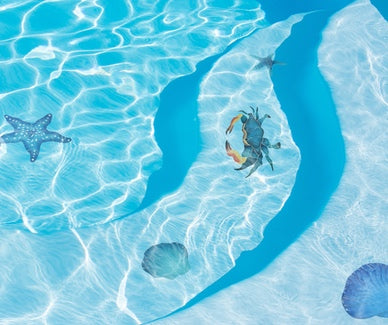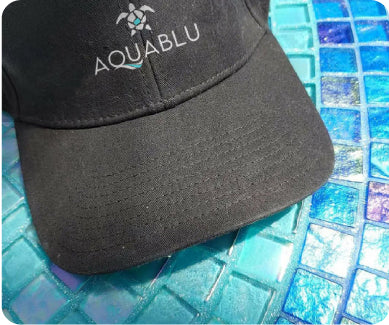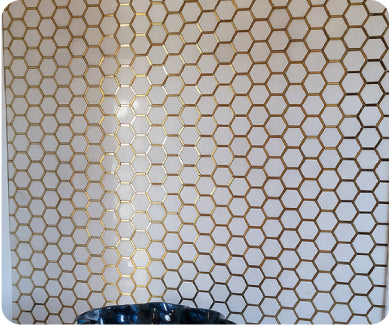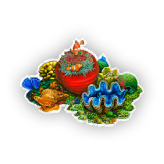AquaBlu Mosaics Volunteers with Coral Restoration Foundation

Earlier this year we had an unforgettable experience volunteering with the Coral Restoration Foundation in Key Largo. This unique opportunity not only gave us a hands-on look into the world of coral reef conservation but deepened our commitment to protecting these fragile ecosystems.

The experience started off in the classroom where we had the privilege of learning extremely important information regarding coral reefs. Did you know that Florida’s coral reef is the third largest barrier reef in the world? We learned quite a bit in the hour-long presentation and enjoyed every minute of it. Here are some insights that we think everyone should know:
- Reefs cover less than 1% of the ocean, but support more than 25% of marine life
- Barrier reefs protect land from erosion, prevent properties from being damaged, and even protect people
- Without corals there would be an imbalance of carbon dioxide levels that would be detrimental to marine creatures
- Reefs are home to over 1 million different species
- More than 3 billion people rely on fish for at least 20% of their animal protein intake
- Recreational diving and snorkeling alone contributed $11 billion to US gross domestic product in 2014 (learn more at dema.org)

It’s easy to forget about the huge importance of these natural wonders. Out of sight, out of mind - right? This learning experience opened our eyes to how corals impact so much more than just marine life.
After the classroom, we had an interactive experience planting corals onto a reef. This was all done out of the water with imitation materials but provided the necessary training that any volunteer would need prior to putting on their dive gear. Planting coral is a meticulous process designed to restore damaged reefs and help revive marine biodiversity. Here is a basic outline of how the Coral Restoration Foundation operates:
- The Coral Restoration Foundation starts by collecting small, healthy coral fragments. Often, these are fragments of resilient coral species, chosen for their natural ability to withstand environmental stressors. These fragments are transported to offshore “nurseries,” where they are placed on structures like coral trees to grow.
- Coral trees are made of PVC pipes that look like underwater trees, which suspend coral fragments in the water column to maximize sunlight and nutrient flow. These “trees” allow corals to grow rapidly without competition from harmful algae. Over the next 6-12 months, coral fragments are closely monitored as they grow into viable new colonies.
- Once the coral fragments are ready, the foundation selects reef sites in need of restoration. Divers and conservationists clean these sites, removing harmful algae and debris to create an optimal environment for the new corals to thrive.
- Divers return with grown coral fragments from the nursery and carefully attach them to the reef. Using marine-safe epoxy or a similar adhesive, they place the coral fragments onto the reef substrate. The glue secures the coral in place but is gentle enough not to harm the fragile organism. After the coral fragments are planted, they need ongoing care and monitoring. The Coral Restoration Foundation regularly checks on these new corals to ensure they’re adapting well, growing, and spreading across the reef. This process can continue for months or even years, with adjustments made to protect the coral from predators or disease.
Over time, the coral colonies grow, creating new habitats for marine life and helping to restore the vibrant ecosystems that reefs support. The Coral Restoration Foundation has successfully used this approach to bring thousands of coral colonies back to Florida’s reefs, underscoring how collective action can revitalize ocean habitats.

The highlight of our experience was an actual visit to the nurseries. Floating below the surface, we descended into a realm where vibrant coral fragments suspended from of vast field of coral trees, each one a beacon of hope for the future of our reefs. Armed with a scrub brush and scraper, we got to work cleaning algae and debris from the trees. Our guides explained how maintaining these nurseries help corals grow faster and more robustly, increasing the odds that they will flourish when reintroduced to the wild.
The dive wasn’t just an exploration – it was a moment of connection and commitment to doing our part to preserve these natural wonders. At AquaBlu, we specialize in an expansive selection of pool tile and pool mosaics, committing a portion of every sale to ocean and environmental conservation. Included in our catalog of pool mosaics are coral reef scenes and marine life, and our customers love creating underwater scenes in their swimming pools. The hard truth is that if we don’t do our part to protect our oceans, the customized pools may be the last vibrant underwater environment to enjoy. We urge customers and the general public to do their part in spreading awareness about the importance of coral reefs and encourage you to donate to the CRF as well. Join us in our unwavering duty to our oceans and to our planet.

Get more information about the Coral Restoration foundation as well as our other conservation efforts here. Together, we can make a difference.


































































































